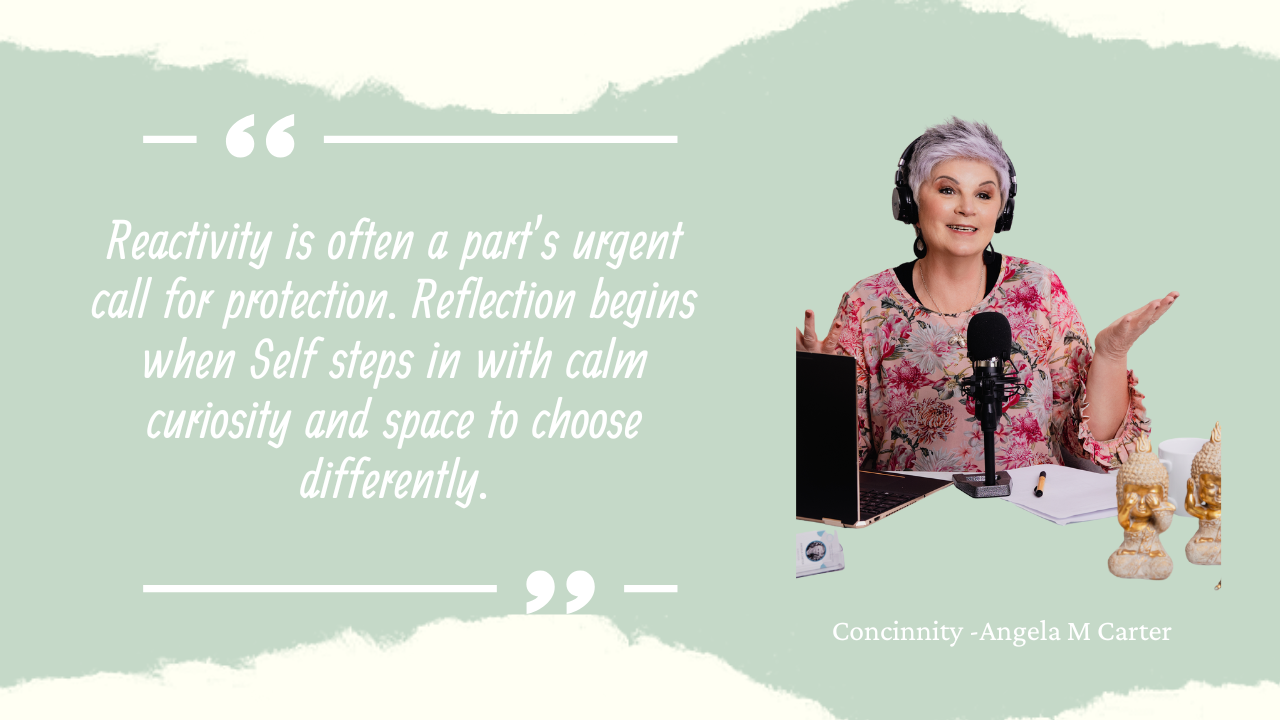From Reaction to Reflection
Dec 24, 2024
How to Know When a Part Is Leading
It’s a normal day. You spill your coffee.
You snap at someone you love.
You scroll your phone, lose an hour, and feel irritated with yourself.
You think, “What is wrong with me?”
Let me pause you right there.
There’s nothing wrong with you.
But there’s a very good chance… a part was leading.
We All React—But We Don’t All Reflect
Most of us are used to reacting to life. We’re not always aware of what’s driving those reactions. They happen fast—automatic, like muscle memory. A sharp tone. A shut-down. A spiral of worry. A fake smile that hides your real feelings.
When we live from our parts, especially the protective ones, our choices tend to come from urgency, survival, or deep habit. And it’s not a fault—it’s what our systems learned to do to keep us safe.
But here’s the gift of the Self-led life:
We can move from reaction to reflection.
We can pause, get curious, and ask:
“Who inside me just took the wheel?”
That one moment of awareness can change everything.
What It Looks Like When a Part Is Leading
Here are some clues you’re in a part, not Self:
-
You feel tense, rushed, or like something has to happen immediately.
-
You’re emotionally flooded—angry, ashamed, panicked, frozen.
-
Your thoughts are black-and-white: “I always mess this up.” “They’re wrong and I’m right.”
-
Your body feels tight or disconnected. You may be on autopilot.
-
You notice you’re replaying or rehearsing conversations over and over.
In contrast, when you’re in Self, you feel:
-
Grounded and spacious.
-
Open to multiple perspectives.
-
Emotionally aware but not hijacked.
-
Kind toward yourself and others—even if you're setting a boundary or feeling sad.
The First Step Is Noticing
The most powerful shift isn’t trying to be in Self—it’s noticing when you’re not.
When you catch yourself mid-reaction and say, “Ah, that’s a part of me,” you’ve already brought in a bit of Self-energy.
It’s like stepping out of the storm just long enough to say, “Okay, something in me is overwhelmed… and I want to listen instead of react.”
This doesn’t mean we never react. We’re human. But with practice, we can shorten the time between reaction and reflection. We can learn to pause before we speak. To breathe before we spiral. To check in before we check out.
A Real-Life Example: The Email That Unleashed a Part
A client once told me about an email she received from her boss. It was short, blunt, and landed like a slap. Instantly, she felt panicked, small, like she was back in childhood being told off.
She wanted to reply defensively—right now.
But then she paused. She said to herself, “Something in me is feeling very young and very afraid. I wonder what this part believes is happening.”
As she slowed down, she realised: this wasn’t about her boss. It was about an old part carrying the burden of being “the good girl.” The part believed that if she was in trouble, she was unsafe.
With that awareness, she didn’t need to overreact. She wrote a calm, clear reply later that day—from Self.
Try This: A Reflection for Reactions
Use this quick reflection to catch yourself in the moment and create space between the part and the pattern.
Step One: Pause When You Notice a Reaction Take a breath. Place a hand on your heart or belly. Say silently, “Something in me is reacting.”
Step Two: Get Curious Ask:
-
What just happened?
-
What does this part of me believe?
-
How is my body responding?
Step Three: Create Space Gently say to the part, “Thank you for showing up. I want to understand you. But I’m here now, and I’m listening.”
This small act of reflection is the doorway back to Self. You don’t need to figure it all out—just be willing to wonder.
Final Thoughts
You don’t have to be perfect.
You don’t have to always respond with poise and grace.
You’re allowed to be human, to react, to make messes.
But now, you also have the awareness to slow down. To turn inward. To ask, “Who’s here, and what do they need?”
That question alone can transform a lifetime of reactivity into a practice of inner relationship.
And that, my friend, is the beginning of real inner freedom.
In abundant love and kindness for all curious souls
Angela xox

